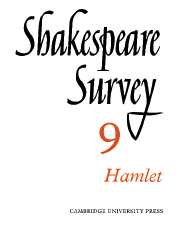Book contents
- Frontmatter
- Studies in Hamlet, 1901–1955
- English Hamlets of the Twentieth Century
- The Date of Hamlet
- Hamlet and the Court of Elsinore
- Hamlet’s ‘Sullied’ or ‘Solid’ Flesh: A Bibliographical Case–History
- Hamlet at the Globe
- Hamlet Costumes from Garrick to Gielgud
- Hamlet at the Comédie Française: 1769–1896
- The New Way with Shakespeare’s Texts: An Introduction for Lay Readers. III. In Sight of Shakespeare’s Manuscripts
- Shakespeare in the Bibliotheca Bodmeriana
- An Unpublished Contemporary Setting of a Shakespeare Song
- Garrick’s Stratford Jubilee: Reactions in France and Germany
- Shakespeare and Bohemia
- International Notes
- Shakespeare Productions in the United Kingdom: 1954
- The Tragic Curve: A Review of two Productions of Macbeth
- The Year's Contributions to Shakespearian Study 1 Critical Studies
- 2 Shakespeare’s Life, Times and Stage
- 3 Textual Studies
- Book Received
- Index
- Plate Section
2 - Shakespeare’s Life, Times and Stage
Published online by Cambridge University Press: 28 March 2007
- Frontmatter
- Studies in Hamlet, 1901–1955
- English Hamlets of the Twentieth Century
- The Date of Hamlet
- Hamlet and the Court of Elsinore
- Hamlet’s ‘Sullied’ or ‘Solid’ Flesh: A Bibliographical Case–History
- Hamlet at the Globe
- Hamlet Costumes from Garrick to Gielgud
- Hamlet at the Comédie Française: 1769–1896
- The New Way with Shakespeare’s Texts: An Introduction for Lay Readers. III. In Sight of Shakespeare’s Manuscripts
- Shakespeare in the Bibliotheca Bodmeriana
- An Unpublished Contemporary Setting of a Shakespeare Song
- Garrick’s Stratford Jubilee: Reactions in France and Germany
- Shakespeare and Bohemia
- International Notes
- Shakespeare Productions in the United Kingdom: 1954
- The Tragic Curve: A Review of two Productions of Macbeth
- The Year's Contributions to Shakespearian Study 1 Critical Studies
- 2 Shakespeare’s Life, Times and Stage
- 3 Textual Studies
- Book Received
- Index
- Plate Section
Summary
The mystery of Shakespeare’s life seems to provoke a monstrous deal of speculation for each poor pennyworth of fact. Those who enjoy pure speculation may derive pleasure from Arthur Field’s Recent Discoveries Relating to the Life and Works of William Shakespeare, which makes some staggering claims, based largely on marginal notes in copies of old books, which, if the ‘facsimiles’ provided are accurate, are neither intelligible nor Elizabethan. Jean Paris cleverly presents a picture of Shakespeare, his age, and his treatment of various themes in carefully chosen quotations from the plays and poems. Shakespeare par lui-même is lavishly illustrated with photographs and facsimiles, and the author’s commentary gives the essential facts, but also airs again the Baconian and other heresies; Abel Lefranc and Percy Allen are named in the bibliography, but not E. K. Chambers. One or two further details relating to Shakespeare have been put forward in articles and notes. H. A. Shield identifies the five people associated with Shakespeare in a complaint of 1615 against Matthew Bacon, and finds a tenuous connexion between one of them and Grafton, Northants, which gave its name to a portrait of the playwright. Sir Giles Isham supports G. M. Young’s suggestion that the story of Lear may be related to the life of Brian Annesley (died 1604), whose youngest daughter of three he now shows was called Cordelia.
- Type
- Chapter
- Information
- Shakespeare Survey , pp. 141 - 148Publisher: Cambridge University PressPrint publication year: 1956

